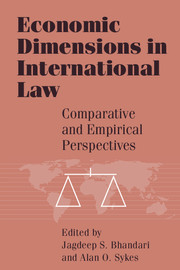Book contents
- Frontmatter
- Contents
- Preface
- Introduction: Economics and international law
- 1 The economics of the most favored nation clause
- 2 The economics of “injury” in antidumping and countervailing duty cases
- 3 The economics of “injury” in antidumping and countervailing duty cases: A reply to Professor Sykes
- 4 Innovations in support of the unitary injury test in U.S. unfair trade cases
- 5 The free trade–fair trade debate: Trade, labor, and the environment
- 6 International conflict and coordination in environmental policies
- 7 Market modernization of law: Economic development through decentralized law
- 8 Toward a positive theory of privatization: Lessons from Soviet-type economies
- 9 New stories on exchange rate policies in transition
- 10 Is deposit insurance inevitable? – lessons from Argentina
- 11 The market for migrants
- 12 The interplay of liquidation and reorganization in the bankruptcy systems of Canada and the United States: The role of screens, gatekeepers, and guillotines
- 13 International political economy approaches to international institutions
- 14 The trade effects of domestic antitrust enforcement
- 15 The Hartford Insurance Company case: Antitrust in the global economy – welfare effects and sovereignty
- 16 Recognition of foreign judgments as a trade law issue: The economics of private international law
- 17 Externalities and extraterritoriality: The law and economics of prescriptive jurisdiction
- Index
10 - Is deposit insurance inevitable? – lessons from Argentina
Published online by Cambridge University Press: 05 December 2011
- Frontmatter
- Contents
- Preface
- Introduction: Economics and international law
- 1 The economics of the most favored nation clause
- 2 The economics of “injury” in antidumping and countervailing duty cases
- 3 The economics of “injury” in antidumping and countervailing duty cases: A reply to Professor Sykes
- 4 Innovations in support of the unitary injury test in U.S. unfair trade cases
- 5 The free trade–fair trade debate: Trade, labor, and the environment
- 6 International conflict and coordination in environmental policies
- 7 Market modernization of law: Economic development through decentralized law
- 8 Toward a positive theory of privatization: Lessons from Soviet-type economies
- 9 New stories on exchange rate policies in transition
- 10 Is deposit insurance inevitable? – lessons from Argentina
- 11 The market for migrants
- 12 The interplay of liquidation and reorganization in the bankruptcy systems of Canada and the United States: The role of screens, gatekeepers, and guillotines
- 13 International political economy approaches to international institutions
- 14 The trade effects of domestic antitrust enforcement
- 15 The Hartford Insurance Company case: Antitrust in the global economy – welfare effects and sovereignty
- 16 Recognition of foreign judgments as a trade law issue: The economics of private international law
- 17 Externalities and extraterritoriality: The law and economics of prescriptive jurisdiction
- Index
Summary
This chapter explores the decision by the Argentine government to abolish deposit insurance, and its subsequent decision to reestablish a form of deposit insurance. Prior to 1991, the Argentine banking system operated under a regime of optional, explicit deposit insurance, coupled with extensive implicit deposit insurance in the form of central bank assistance to failing banks. In 1991 and 1992, Argentina reversed this policy by repealing the country's deposit insurance program and attempting to convince financial markets that it would not under any circumstances rescue a failing bank. In 1995, in the face of a forthcoming election and a severe economic crisis sparked by the Mexican peso devaluation of December 1994, the Argentine government reinstituted a form of deposit insurance in an effort to stave off an all out bank panic. The decision to reestablish deposit insurance appears inconsistent with repeated assurances from high-level officials to the effect that the Argentine government would not under any circumstances bail out depositors in a failing bank.
Beginning in December 1994, Argentina's banking system entered a major period of instability triggered by the peso devaluation and subsequent economic crisis in Mexico – the so-called tequila effect in which the Mexican problems spread out to other countries in the region and even elsewhere in the developing world.
The connections between the Mexican crisis and the loss of investor confidence in Argentina are somewhat difficult to determine.
- Type
- Chapter
- Information
- Economic Dimensions in International LawComparative and Empirical Perspectives, pp. 392 - 404Publisher: Cambridge University PressPrint publication year: 1998



